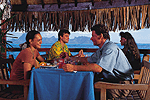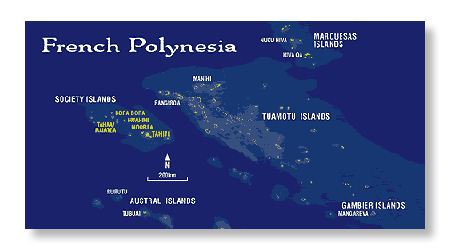LOCATION
Tahiti
is only 7-1/2 hours non -stop flying time from Los Angeles. French
Polynesia lies in the South Pacific between Australia and North
America. It is in the same time zone as Hawaii and is about the
same distance below the equator as Hawaii is above it. |
ENTRY
REQUIREMENTS
U.S. and Canadian citizens need a passport valid 6 months
after your return date. If your passport is other than U.S. or Canadian,
check with the French Consulate. No immunization certificates are
required. It is solely the passenger's responsibility to ensure
that all documents needed are complete and current. |
CLIMATE
Cooled by the gentle breezes of the Pacific, the weather
in Tahiti is sunny and pleasant with a yearly average temperature
of 79 degrees F. Roughly speaking, there are two seasons: warmer
and humid are the months that span November through May while June
through October bring a cooler and drier climate. Most of the rain
falls during the warmer season, however there will be showers in
the drier season and lots of sunshine in the humid season.
|
CLOTHING
Tahiti is very informal. Lightweight, natural fabrics
such as cotton will serve well. Men will be comfortable in shorts,
slacks for dinner, sport shirts and sandals, while ladies may wear
shorts, skirts and sundresses. We also recommend taking along a
couple of swimsuits each, rubber-soled shoes for reef walking, hat
or sun visor, sunglasses, sunscreen, insect repellent, and a waterproof
bag to protect camera equipment. |
 CURRENCY
AND EXCHANGE CURRENCY
AND EXCHANGE
The Pacific French franc (CFP) is the currency used in
French Polynesia. It is different from the French franc. Banks are
located at Tahiti's International Airport and on each island. Hotels
also exchange money but tend to give a less favorable rate than
banks. Most major credit cards are accepted in Tahiti. |
NO
TIPPING AND NO TAXES
Tipping is not customary, Polynesian hospitality simply
does not allow it. Through out French Polynesia there are no sales
taxes or service charges. Consider these savings when comparing
Tahiti with other destinations. |
LANGUAGE
French and Tahitian are the official languages. English
is spoken in hotels and in most shops and restaurants, so communication
is rarely a problem. Tahitians truly appreciate visitors who try
to learn a few of their words. They enjoy helping and you can expect
a broad grin or hearty laugh as they teach and you try.
|
HEALTH
French Polynesia enjoys a high standard of health, with
excellent medical and dental facilities. The tropical sun can be
deceptively penetrating, so be sure to use a good, waterproof sunblock
to protect your skin from overexposure. The water is generally safe
to drink however; we suggest bottled water available through the
hotels. Medications, even aspirin, should be brought from home,
as pharmacies are not always convenient to hotels. |
ELECTRICITY
The electrical voltage is 220v in Tahiti. Most
hotels have 110v outlets for electric razors. A converter/adapter
kit will generally be needed for other appliances made with the
U.S. standard of 120v. |
 DINING DINING
You will discover a palate-pleasing variety of native
dishes, Chinese, French and American cuisine. You will delight in
the abundance of seafood, tropical fruits and fresh vegetables.
You can eat at fine restaurants or outdoor cafes, partake of Polynesian
feasts and beach barbecues. There are few restaurants on the outer
islands other than those within the hotels. Meal plans are available
prior to the start of your trip and will generally represent cost
savings. Meal prices are comparable to those at better restaurants
in other resort destinations. Most restaurants have a la carte menus
so that you will not have to order a complete meal if all you want
is a salad. A package that includes meals represents a value. However,
if a package does not include meals, my suggestion is to leave some
days open so you can venture out from your hotel and experience
other island restaurants. Pre-purchasing meal plans not included
in a package represents more of a convenience than a savings.
|
SCUBA
DIVING
Diving in French Polynesia is colorful, varied, and among
the best anywhere. You will encounter a myriad of colorful reef
fish, moray eels, turtles, even manta rays and sharks. The translucent
waters are warm (80° and above) and clear (100 foot visibility)
and full of colorful, exciting marine life...no matter which island
you choose to explore. Moorea specializes in hand-feeding
sharks and dives with rays and dolphins, along with a variety of
reef fish and low-growing corals. Bora Bora generally offers
beautiful, graceful manta rays in its plankton-rich multi-hued lagoon.
Huahine and Raiatea offer more brilliant displays
of coral ledges and cliffs, along with varieties of colorful reef
fish. However, it is the Tuamotu atolls of Rangiroa and Manihi
where more experienced divers will enjoy the fullest diversity of
marine life, with dives starting along the outer reefs, drifting
through the passes, and into the lagoons. It is high excitement
diving with black-tip and white-tip sharks everywhere and occasionally
silver-tip or hammerhead. |
 SHOPPING SHOPPING
Black pearls, hand-blocked fabrics, exquisitely carved
bowls, drums, tikis, local shell craft, baskets, dance costumes
and vanilla beans can all be purchased in the markets and shops
of Tahiti. French imports such as perfumes, are available in duty
free shops. Stores are normally closed daily for a long lunch, on
Saturday afternoon and all day Sunday. |
TELEPHONE
Direct dialing for local and international telephone
calls is easy in French Polynesia, whether calling from your hotel
or from the public phone booths. Most of the public telephones can
be operated with phone cards, which can be purchased in various
denominations at the post office, convenient stores and airports.
|
 CHURCHES CHURCHES
Religion is very important to the Tahitian people. The
church, whether Protestant or Roman Catholic, is the center of activity
in all villages. Attend a Sunday service, you will find the Tahitians'
singing to be beautiful and moving. Guests are certainly welcome
in places of worship as long as they adhere to the usual decorum:
men should wear long pants and shirts, and women should wear subdued
dresses. |
|
WEDDING
CEREMONIES*
A traditional Tahitian wedding ceremony for many is a dream
come true. There is not a more romantic way to exchange or renew
personal vows. You may choose from several locations with in the
islands and ceremonies range from simple to lavish. *Weddings
are not legal ceremonies. Couples intending to marry legally can
do so before arriving in Tahiti, then exchange promises in one
of the traditional ceremonies. Check out our
Wedding
ceremonies.
|
GEOGRAPHY
The most
beautiful islands in the world

Officially
known as French Polynesia, Tahiti and her islands are sprinkled
over one and half million square miles of ocean in the South Pacific.
The total land area of the 118 islands and atolls adds up to 1,544
square miles and consists of five archipelagoes: the Society Islands,
Austral Islands, Marquesas Islands, Tuamotu Atolls and the Gambier
Islands.
|
The
SOCIETY ISLANDS
are the main tourist destinations in French Polynesia.
They are divided into the Windward Islands and the Leeward Islands.
The Windward Islands include the high islands of Tahiti and Moorea,
plus the coral atoll of Tetiaroa. The Leeward Islands are made up
of Huahine, Raiatea, Tahaa, Bora Bora and Maupiti. |
The
TUAMOTU ARCHIPELAGO
is located approximately 200 miles northeast of Tahiti and is the
largest collection of coral atolls in the world. It is made up of
83 atolls that are ring shaped coral islands encircling a lagoon.
In the early seventies, pearl farms in the Tuamotus began to produce
the black pearl, a jewel that has since become the symbol of French
Polynesia. Rangiroa, Manihi, Tikehau and Fakarava are the main tourist
destinations in this archipelago. |
The
AUSTRAL ARCHIPELAGO
consists of 5 high islands that lie on both sides of
the Tropic of Capricorn, extending in a northwest-southeasterly
direction across 794 miles of ocean. Steep cliffs rise dramatically
from the sea with few white sandy beaches. This group of islands,
like the Marquesas, is renowned for its original art, carved wooden
objects and basketwork which is exported to Papeete. |
The
MARQUESAS ARCHIPELAGO
consists of 6 inhabited islands and 6 smaller unpopulated
islands. They are divided into two distinct groups about 60 miles
apart. In the northern group is the island of Nuku Hiva that is
the administrative and economic center. Also in this group are Ua
Huka and Ua Pou. In the southern group are Hiva Oa, Tahuata and
Fatu Hiva. |
The
GAMBIER ARCHIPELAGO
Also known as the Mangareva Group, is 1,057 miles southeast
of Tahiti. The climate in these southern latitudes is very mild,
with cooler temperatures than Tahiti. The Gambier Islands are the
cradle of Catholicism in French Polynesia, as the first missionaries
arrived here in 1834. These islands, once inhabited by several thousand
people, are now almost deserted today. |

